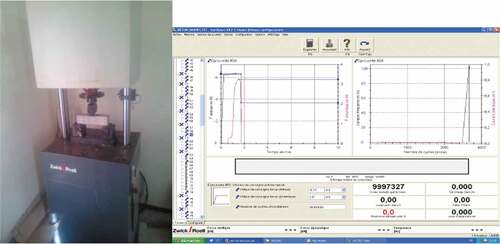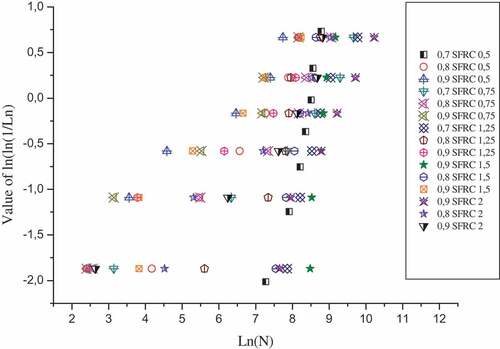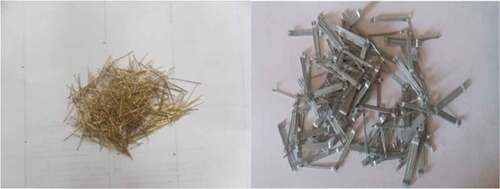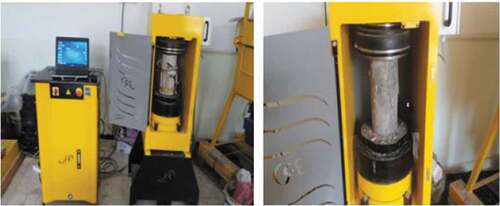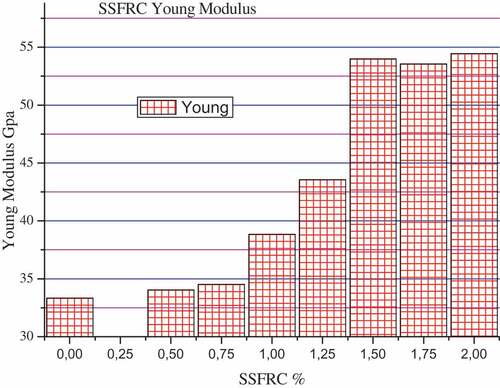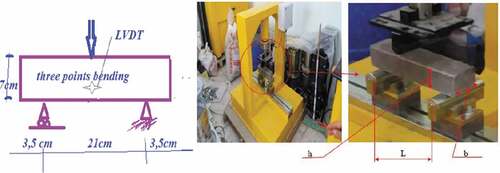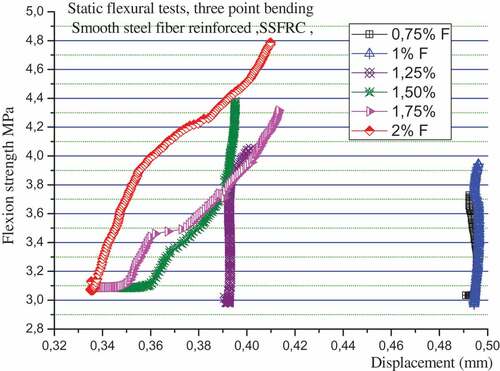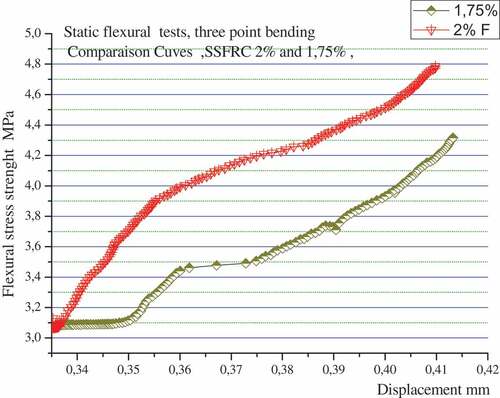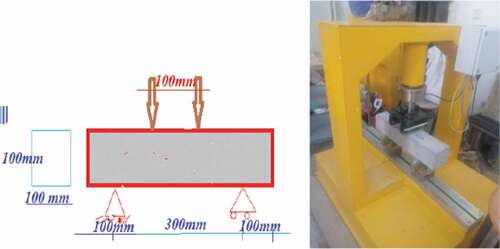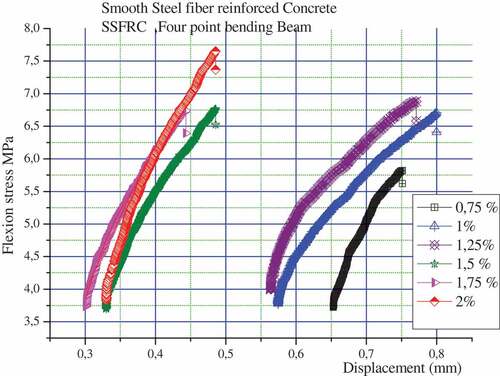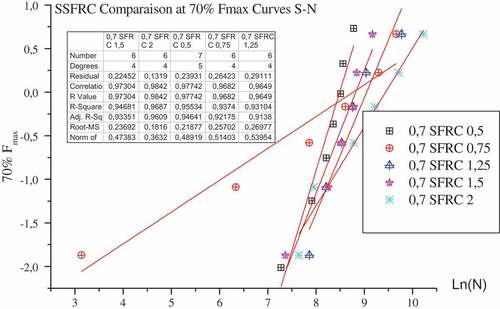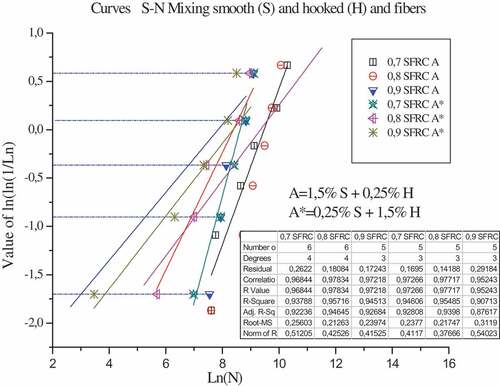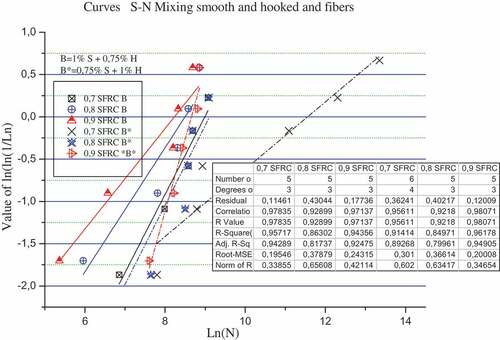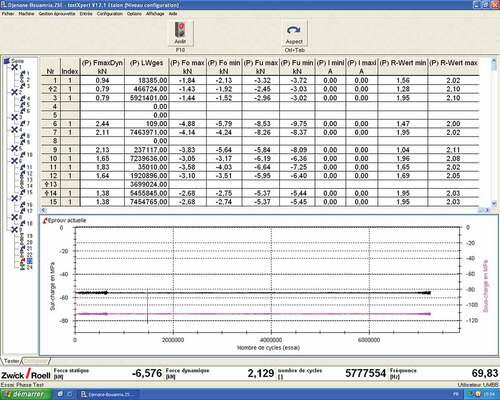 ?Mathematical formulae have been encoded as MathML and are displayed in this HTML version using MathJax in order to improve their display. Uncheck the box to turn MathJax off. This feature requires Javascript. Click on a formula to zoom.
?Mathematical formulae have been encoded as MathML and are displayed in this HTML version using MathJax in order to improve their display. Uncheck the box to turn MathJax off. This feature requires Javascript. Click on a formula to zoom.Abstract
This paper presents an experimental study on flexural fatigue dynamic behavior of reinforced concrete. Steel fiber is used for the retrofitting and strengthening flexural members, by mixing short smooth steel fiber and hooked-end fiber. By using Vibrophore HFP 150, dynamic loading was scanned at a resonance frequency of 100 Hz. Our objective is to examine the behavior of a specimen of 7 × 7 × 28 by a three-point bending test under high-level stress until it fails. Important research has been conducted to investigate the static and fatigue behavior of reinforcement. It was strengthened initially using one fiber, then using other additives. However, this research is not adequate to examine the flexural fatigue behavior of specimens by mixing different shaped fibers at different percentages. A further improvement in composite concrete performance is observed by mixing two steel fibers under high-level stress. The results are in alignment with the fatigue life data using Weibull distribution.
PUBLIC INTEREST STATEMENT
In order to assess the strength of structural elements under fatigue loading, it is imperative to examine the relationship (strain–stress) of concrete reinforced with steel fibers, and in the case of standardization in design, these data can be used for the fatigue limit states, else for new or old existing concrete elements.
The experimental study evaluates the number of cycles for three-level stresses under flexural loading of reinforced concrete with primary smooth steel fiber, then by mixing smooth with hooked and steel fiber.
Results of investigation show that it is possible to predict the fatigue life by using Weibull distribution.
1. Introduction
Brittle materials or matrices have been strengthened with fibersfor a long time. For research papers,Romualdi in 1963 and 1964 consideredsteel fibers as reinforcement for concrete. Several properties of concrete have been improved by incorporating steel or other fibers and implicating in structures such as bridge decks, machine foundation, airport etc. Nevertheless, these structural elements (bridge decks, dynamic machines etc.) are built by cyclic loading. Repeated loading during the service is not made in the same pulse; it can be said that fatigue is a progressive, permanent, internaland structural process.
Applications in building and civil engineering structures of steel fibers reinforcement are significantly important. But even in researches in recent years, experimental evaluations of this behavior have been carried out (Arora & Singh, Citation2018; Chandrappa & Biligiri, Citation2017; Kyu-Seok, Yoon-Sang, Kwan-Kyu, & Jung Citation2017). Numerous practical applications are expected to be used in static loading behavior. However, fatigue dynamics of smooth steel fibers mixing hooked-end reinforced ordinary concrete is used infrequently for different percentages.
Behavior of materials even under fatigue loading has been studied for many reinforcement concretes. There have been many studies on fatigue strengthening using textile-reinforced concrete (Parvez & Foster, Citation2017), (Carbon Fiber Reinforced Polymer) CFRP materials and different materials (Colombi, Bassetti, & Nussbaumer, Citation2003; Ghafoori, Motavalli, Zhao, Nussbaumer, & Fontana, Citation2015; Ghafoori, Schumacher, & Motavalli, Citation2012; Täljsten, Hansen, & Schmidt, Citation2009; Wu, Zhao., Al-Mahaidi, Emdad, & Duan, Citation2013); the influence of recycled concrete aggregates geopolymer concrete (Parthiban & Saravana, Citation2016).
Different specimens and tests such as compressive, flexural, three points and four points, are summarized at different frequencies. Specimens of size 100 × 100 × 500 mm were tested under four-point flexural fatigue loads applied at a frequency of 10 Hz. It has shown that the fatigue life distributions of concrete are made with 100% (recycled) RCA and 100% (nature) NA (Arora, & Singh, Citation2018; Arora & Singh, Citation2016). The fatigue behavior of a high-strength concrete was investigated considering the influence of maximum stress level, loading frequency and waveform, but Nadja studied for low-cycle fatigue. The loading frequency was chosen between f = 0.1 and 10 Hz (Oneschkow, Citation2016). The force was applied in load control using a sinusoidal wave at a frequency of 3 Hz (Parvez & Foster, Citation2017). Specimens of size 10 × 10 × 50 cm were tested under four-point flexural fatigue loads applied at a frequency of 10 Hz (Arora & Singh, Citation2016). (Medeiros, Zhang, Ruiz, Yu, & Velasco, Citation2015) cubes specimens of 10 cm length studied at four different loading frequencies, 4, 1, 1/4 and 1/16 Hz, (Jang, Kim, Kim, Min, & Lee, Citation2014) 10 × 10 × 40 cm were tested under flexural fatigue, at a frequency of 1 Hz.
A specimen of size 10 × 10 × 50 cm for static flexural and flexural fatigue tests, with constant amplitude and sinusoidal loads that were applied at a frequency of 10 Hz (Goel & Singh, Citation2014; Goel, Singh, & Singh, Citation2012; Houari, Benkechkache, & Debicki, Citation2014), was used (mild steel hardened), which had cylindrical shape, fitted with hooked-end (noted HE) at a frequency of 1.8 Hz. It is necessary to develop fatigue models for non-reinforced concrete and steel fiber-reinforced concrete (SFRC) with local materials that allow quantifying the effect of steel fibers in materials’ fatigue life (Ruiz-Valencia, Rodríguez, & León-Neira, Citation2017).
In general, variation in loading frequencies in the range of 1–30 Hz has insignificant effect on the fatigue behavior of concrete if the maximum stress level is kept less than 75% of the static strength (Awad & Hilsdorf, Citation1974). Fatigue life prediction and the design of SSFRC structure elements can also be performed through an empirical approach. But differences in performances of the characteristics of materials can be in discord with empirical approach. Few researches, on the fatigue of SSSFRC, are published. The fatigue performance is relatively related to local materials used and homogeneous concrete.
In the present study, A Vibrophore Zwick HFP 150 is used to determine flexion fatigue strength, realized at URMPE Laboratory University of Boumerdes, fatigue life and fatigue limit, fatigue testing flexion. In the present investigation, an upper limit of 5 million cycles was chosen to estimate the life duration of a structure that may typically be subjected to flexural fatigue loading for all specimens SFRC
Short smooth steel fibers are used because of the conclusion; the presence of fibers, especially bigger ones, may be an additional cause of imperfections, creating stresses (Cachim, Figueiras, & Pereira, Citation2002), but Betterman, Ouyang and Shah (Citation1995) define the damage on interfaces of fiber–matrix and aggregate–matrix, as the weakest phase in concrete and SFRC, as it is responsible for fatigue crack initiation and growth in reinforced concrete. Smooth fibers exhibited higher fracture strength and energy than twisted fibers (Tran, Tran, Jeon, Park, & Kim, Citation2015). Soufeiani et al. (Citation2016) and Yoo and Yoon (Citation2015) tested 10 large (Ulta High Performances Concrete) UHPC beams with two different reinforcement ratios and steel fiber types (smooth and twisted steel fibers). The results showed that adding steel fibers significantly improved load-carrying capacity, post-cracking stiffness and cracking response but decreased ductility. The researchers determined that by adding 2% steel fibers by volume, load-carrying capacity has increased by 27–54%.
2. Mechanic tests and materials
Portland cement class CEMII 42.5N was used in this study. Mechanical characteristics on day 28 are 44.7 MPa for compressive strength and 5.7 MPa for the flexion test. High water reducer ADVA flow 390. A nominal maximum size aggregates of 15 mm Azrou Kaddara career with a density of 2.72 kg/m3 were used. Effects of fibers DRAMIX smooth steel fibers (15 mm) and hook-end (30 mm) on fatigue dynamic of reinforced concrete are shown in Figure . Table shows the characteristics of biers used in the current study.
Table 1. Characteristics of fibers
The mix proportions for (smooth and mixed) concrete mixes used for casting the specimens are shown in Table to investigate the effects of the different reinforcement mixing fibers on static load and the flexural fatigue performances of the beams; the specimens were cast in 11 batches; each batch consists of 11 standards beam specimens of size 7 × 7 × 28 cm for static flexural and flexural fatigue tests and three cylindric specimens of size 160 × 320 mm for obtaining its 28 days compressive modulus. The specimens were demolded after 24 h of casting.
Table 2. Concrete mixture proportions used in the study
The beam specimens were cured under laboratory conditions until testing strength succumbs.
2.1. Static tests
2.1.1. Compressive extensometer
Young modulus: measured on cylinders specimen dimensions tests 16 × 32 cm (Figure ) in BOUIRA University laboratory. The improvement of compressive strength of all the mixtures tested in this investigation is shown in Figure . The increase in the Young modulus can be observed, with increasing percentages of fibers.
Histograms show proportionality of concrete’s rigidity with incorporation steel fibers and sensitive at volume fractions (1.5%, 1.75%, and 2%).
2.1.2. Flexural
2.1.2.1. Flexural test (three-point bending)
About 70 static flexural tests were also carried out to determine the static flexural strength of SSFRC and MSFRC. The representative test methods for SFRC currently available are the ASTM C1609 and EN (Citation2001) methods.
The specimens incorporated 0.5%, 0.75%, 1.0%, 1.25%, 1.5%, 1.75% and 2.0% volume fraction of short smooth steel fibers and mixing two types (smooth and hooked-end) steel fiber at different percentages.
The static flexural strength tests on batches of SCFRC were conducted just prior to fatigue tests. For this purpose, three specimens on a beam 7 × 7 × 28 cm from each batch were tested under three point static flexural loads. See the scheme and Figure ; the mean static flexural strength was obtained.
From the above results, it can be seen in Figure that the improvement of flexural strength becomes more obvious with the increase in the volume fraction of fiber. The load–deflection curves quantitatively are in the function with increasing contained fibers but how the fibers influence the discontinued branch and slope curve depends on connection cement-matrix and fibers at section friction. The efficiency of hardened composite of SFRC is mainly related to the ability of its components to work together homogeneously (Khabaz, Citation2016).
The load/deflection curves in Figure show differences in slope-curves and ultimate flexion displacement, where 0.75%, 1% and 1.25 % have max displacement in few time (brittle). It is also observed that plain concrete shows brittle behavior. When subjecting the specimen of the plain concrete to the flexural loading, it will break into two parts once a bending crack occurs. But for the 1.75 % and 2%, it gives regular curves FRC (see details in Figure ). Addition of these volume fractions of fiber effectively slows down the propagation of crack and thus improves the enhancement of flexural behavior and toughness of the specimen.
The static test results showed (Figure ) the qualitative differences in the flexural curve for the reinforced concrete 2% and 1.75% where pull-out fibers at the friction section depend on the contained fibers. The difference depends on the percentage of the content, where the fiber is bridging the section and pressing the brittle failure. Infinitesimal reversed movement of fibers along the interface, damage of interface and repeated fatigue load can be defined as applied permanent pull-out processes. These microscopical changes cause degradation in material properties and show irregular curves.
2.1.2.2. Flexion four-point bending
In order to enrich the investigation on static loads, approximately 18 beam specimens of size 500 mm × 100 mm × 100 mm were tested under four-point flexural static loading. A four-point loading configuration (Figure ) was adopted, and the midpoint deflection was measured.
The static flexural strength four points bending of plain concrete was 4.15 MPa. Increasing fibers fraction from 1.0% to 2.0% had a significant beneficial effect on the static flexural strength of concrete (Figure ).
A linear part is observed on the curves (for the beginning of loading), followed by a nonlinear phenomenon, which corresponds to a localization of the damage around one or more cracks.
Figure shows the similarity between the curves of SSFRC (1.5%, 1.75% and 2%) which gives deflection under 0.5 mm, but the reinforced concrete, with volume fraction (0.75%, 1% and 1.25%) deflects upper by 0.7 mm.
There was an increase of 41%, 65% and 84% in the static flexural strength of SFRC over the plain concrete with reinforcement with steel fibers as Houari et al. (Citation2014) conclude that the deflections, which correspond to the maximum loads, are even more greatly increased since they can reach seven times those of mortars without fibers (700%).
2.2. Dynamic fatigue
During their life cycles, concrete structures such as parking garages, bridges and industrials pavements are subjected to fatigue loading. It is important to understand their fatigue behavior.
The loading points in flexural fatigue tests were kept the same as in static flexural tests (three points bending), since fatigue tests are expensive and time-consuming, the tests were performed on six specimens, and for mixing fibers we have chosen specimens with significant flexural values.
2.2.1. Loading applied (coupling static and dynamic)
Flexural fatigue dynamic tests were carried out using a Vibrophore HFP 150 (Figure ). Dynamic loading was applied to attend resonance frequency speed under a maximum apparatus frequency of 300 Hz. This investigation of the flexural fatigue behavior of SFRC involved nine different mixed proportions. The parameters of the fibers, such as fiber type, were varied; it was decided to take the product of smooth steel fiber separated and mixed smooth with hooked-end at different volumes.
The principal variables causing fatigue failure of both steel and composites are in the range of applied stress; three stress levels S (S = fmax/fr) were conducted 0.7–0.8 and 0.9 for the flexural fatigue tests, considering a simply supported specimen 7 × 7 × 28 cm specimen loaded in flexural bending fatigue loads with a constant coupling the maximum and minimum loads (see the examples in Figure ).
After N number of cycles in bending load to the point of collapse, a finely crack had appeared after failure fatigue compared to static testing. The fatigue damage failure processes of fiber-reinforced concrete were different static failure process, microfibers, short steel fiber, etc., which can bridge microcracks and restraint their formation and propagation in a small scale (Biao, Yin, Lihua, Yuchuan, & Changning, Citation2018).
However, small apparent cracks are shown on reinforced-concrete for SSFRC 0.5% and SSFRC 0.75%.
The fatigue changed the confinement of reinforced concrete, where fibers bridging crakes as well as specimen are consolidate as (Ivanova & Assih, Citation2016) observed. So after optimum consolidation concrete phase, constituent capacity under cyclic loading decrease and breakage phase is observed.
The aggregate bridging force as well as the fiber bridging force decreases with the number of cycles, due to interfacial damage (Zhang & Stang, Citation1997), or fiber breakage due to surface abrasion (Matsumoto, Citation1998).
The fatigue damage progressive on material constituents is responsible for fatigue life of a material. For reinforced concrete, the material phases can broadly be classified as matrix (cement paste and aggregates), fibers, as well as the interfaces of fiber–matrix and aggregate–hydrated cement paste. The fatigue loading causes these physical phases to undergo microscopic changes, such as opening and growth of bond cracks, which exist at the interface between coarse aggregate and hydrated cement paste even prior to the application of load (Neville & Brooks, Citation1987).
Figure shows that the relative example registered for composite SSFRC (0.5% and 0.75%) applied loading system increases with increasing level stress, but for 2%, 1.5, 1.75 the system’s curves are not proportional to level stress, as SSFRC 2%; [the (S = 0.8) begins before level stress (S = 0.9)].
The frequencies of the fractions (0.5% and 0.75%) have the same changes, so the upper rise increases with increasing loading and decreasing of time loading applied. For plain concrete S(0.70) loading participates in consolidating the specimen, but for the level stress (0.90) where the loading is important, the elastic properties are limited. Irregular frequency changes after incorporating 0.75%, 1.25% of smooth steel fibers, where we suppose that homogeneity of the specimen is not satisfied. So the intrinsic property differs between specimens, because of unsaturated fibers.
2.2.2. Fatigue analysis
Graphical method and the method of maximum likelihood have been employed to assimilate the fatigue life (Tables –) data of reinforced concrete with smooth steel fibers by the two parameters Weibull distribution at a given stress level. The reliability function LN (n) of the two-parameters Weibull distribution may be written as follows: expression (Goel et al., Citation2012; Gumble, Citation1963; Mohammadi & Kaushik, Citation2005; Oh, Citation1986, Citation1991; Tse, Lee, & Klaiber, Citation1986) ranging the fatigue life data at a given stress level in ascending order.
Table 3. Flexural fatigue life data (N) of SSSFRC with 0.5% and 0.75% steel fibers
Table 4. Flexural fatigue life data (N) of 1.25%and 1.5% and 2% smooth steel
Table 5. Flexural fatigue life data (N) of B and B− (mixed fibers)
Table 6. Flexural fatigue life data (N) of A and A− (mixed fibers)
where i is the failure order number, and k is the number of fatigue data points at a given stress level S. A graph is plotted between the ln[ln(1/LN)] and ln(N), at a particular stress level (Arora & Singh, Citation2016; Goel et al., Citation2012).
For the maximum likelihood function may be expressed as
2.2.2.1. S–N level stress and cycles number
The average static flexural force of SSFRC reinforced with 0.75%, 1.0%, 1.25%, 1.5% and 2.0% fibers volume fractions were between 11.4 and 11.7 kN, only plain concrete and 0.5% SSFRC were below. The results of the flexural fatigue dynamic tests show that the flexural strength of reinforced concrete with short smooth steel fibers is interesting beginning from 0.75 % and it is about 26.3% higher than the corresponding plain concrete strength for the majority of batches and it is 11% higher than 0.5% SSFRC. However, the test results showed a decrease in the number of cycles for all SSFRC with increasing dynamic loading.
Smooth steel fibers follow approximately straight line; a linear regression analysis of each set of data (Figure ) has been carried out and plotted in a semilogarithmic format in the form of S–N curves.
Figure represents the analysis of the fatigue life data of reinforced concrete with only smooth steel fibers, for the fatigue level stress 0.7 expressed as a percentage of the corresponding static flexural strength. The corresponding values of the correlation coefficient, Cc, are 0.977, 0.968 and 0.9649, 0.9641 and 0.982 for concrete made with smooth steel respectively 0.5%, 0.75%, 1.25%, 1.5%, 1.75% and 2% SSFRC, at level stress 0.70.
2.2.2.2. Mixing fibers SSFRC 15 mm and hooked-end 30 mm
Figure represents the S–N relationship for the reinforced concrete with short smooth steel fiber and mixed with hooked-end fibers.
Approximately follows a straight line. The corresponding values of the correlation coefficient, Cc, are between 0.952 and 0.978 for concrete made with (A) and (A−) (1.5% and 0.25%) smooth and hooked-end but Cc is 0.92, for B and B− (mixing 1% and 0.75%) of smooth and hooked-end at (S = 0.8) stress and 0.98 for (S = 0.9) level stress.
The effect of mixing two types of fibers shown (see Figures and 1) can be observed that (B and B−) with small variation 0.25% or with concentration of 1.5% (A, A−), concrete behavior enhanced using hooked-end fiber, especially at high level (S = 0.9), so the values of the Weibull parameters obtained by graphical method for curves S–N of flexural fatigue dynamics are α = 0.9252 and μ = 8,043.7465; and α = 0.3981 and μ = 104,573.8534 for reinforced concrete with B (1%S + 0.75H) and concrete B− (0.75%S + 1H) respectively at stress level, S = 0.70.
Weibull parameters are α = 0.8076 and μ = 12,997.4848; and α = 1.0487 and μ = 5,974.4166 for reinforced concrete with A (1.5%S + 0.25H) and reinforced concrete with A− (0.25%S + 1.5H) respectively at stress level, S = 0.90.
Similarly, the values of Weibull parameters (α and μ) obtained at other stress levels and percentages have been tabulated in Table .
Table 7. The table summarizes the two parameters Weibull distribution, as a reasonable supposition for the description of fatigue test data at that stress level
At level stress (S = 0.9) important influence for SSFRC 1.5%, in variability on the number of cycles (see Figure ), However, curves are inclined to the same slope for smooth and hooked-end SFRCs A.
Flexural fatigue life of reinforced concrete at high frequency, smooth steel (15 mm) is confined in matrix, because of the geometries, however hooked and mixed with smooth, facilitates failure and limit in variability on the number of cycles. In concretes (A) the number of cycles to failure under high-frequency gets more numerous to that (A−) (see Figure1).
3. Conclusion
Recent investigations showed that (S–N) fatigue bending strength SFRC follows a straight line. This study includes an experimental investigation on the behavior of SFRC (smooth steel and mixing two types of fibers) under fatigue dynamic loading.
Results selected about the influence of steel fiber (separated and mixed) on the numbers of cycles to failure under flexural fatigue are presented in this paper, for the three investigated stress levels. Fatigue tests were conducted on beams specimens 7 × 7 × 28 cm (SFRC) with the intention to evaluate its flexural fatigue performance.
In addition to the literature research, the results also show that there is a direct relation between frequency, constituents and the fatigue life (the number of cycles) S–N. Compared with static force, reinforced concrete with 2% smooth steel fiber gives the higher number of cycles.
It was found that at level stress S studied (0.7, 0.8, 0.9) and high frequency, distribution of fatigue life data can be approximately modeled by the two-parameter Weibull distribution, where the values of the shape parameter for fatigue life obtained for reinforced concrete SSSFRC are inversely proportional to stress level compared with concrete studied (Arora & Singh, Citation2016), 0.9050, 0.4780 and 0.3683 for stress level S, respectively (0.7, 0.8, 0.9) for SSFRC 2%, but for concrete specimens mixed in proportions A (1.5% S + 0.25H) and B (1% S + 0.75H), values of the shape parameter are proportional with applied stress level (0.7, 0.8, 0.9).
The number of cycles is enhanced by adding 0.25% of hooked-end to 1.5% of smooth steel for all the studied stress levels.
This indicates that the parameter (shape of fiber) is important where we conclude that smooth steel is pulled out from cement matrix at high stress level, then it converges to a limited number of cycles.
Waiting for the failure of each specimen is hazardous, but logarithmic functions are useful relations to estimate the fatigue life. To perform some series of tests as distribution, steel per units of area is the perspective study.
Acknowledgements
The steel fibers used in this study were provided by ALCAHYD, thanks to the Laboratory of ENGOA Reghaya engineering technician.
Additional information
Funding
Notes on contributors
Nacira Saoudi
Nacira Saoudi is currently pursuing her PhD in Faculty of Engineering, M’hamed Bougara of Boumerdess. Her current research interest focuses on steel fiber-reinforced concrete, static and dynamic loading, cracking and estimate probability of fatigue life.
Boudjema Bezzazi
Boudjema Bezzazi is working as a professor in Faculty of Engineering, M’hamed Bougara of Boumerdess. His research interests concerns renewable material and enhancement of behavior waste.
The present research work is one area of interest, reinforced concrete with fibers, its study of mechanical and estimate probability fatigue life function. Concrete performance, cracks growth, matrix fractures and their aspects incorporating industrial waste (different form of steel fibers).
References
- Arora, S., & Singh, S.-P. (2016). Analysis of flexural fatigue failure of concrete made with 100% coarse recycled concrete aggregates. Construction and Building Materials, 102, 782–17. doi:10.1016/j.conbuildmat.2015.10.098
- Arora, S., & Singh, S.-P. (2018). Flexural fatigue performance of concrete made with recycled concrete aggregates and ternary blended cements. Journal of Sustainable Cement-Based Materials, 7(3), 182–202. doi:10.1080/21650373.2018.1471423
- ASTM C 1609/C 1609M-06. Standard test method for flexural performance of fibre-reinforced concrete (Using beam with three-point loading). USA.
- Awad, M. E., & Hilsdorf, H. K. (1974). Strength and deformation characteristics of plain concrete subjected to high repeated and sustained loads. Fatigue of Concrete ACI Special Publication, 41, 1–13.
- Betterman, L. R., Ouyang, C., & Shah, S. P. (1995). Fiber-matrix interaction in microfiber reinforced matrix. Advanced Cement Based Materials, 2, 53–61. doi:10.1016/1065-7355(95)90025-X
- Biao, L., Yin, C., Lihua, X., Yuchuan, S., & Changning, L. (2018). Experimental investigation on the flexural behavior of steel-polypropylene hybrid fiber reinforced concrete. Construction and Building Materials, 191, 80–94. doi:10.1016/j.conbuildmat.2018.09.202
- Cachim, P.-B., Figueiras, J.-A., & Pereira, P.-A.-A. (2002). Fatigue behavior of fiber-reinforced concrete in compression. Cement & Concrete Composites, 24, 211–217. doi:10.1016/S0958-9465(01)00019-1
- Chandrappa, A. K., & Biligiri, K. P. (2017). Flexural- fatigue characteristics of pervious concrete: Statistical distributions and model development. Construction and Building Materials, 153, 1–15. doi:10.1016/j.conbuildmat.2017.07.081
- Colombi, P., Bassetti, A., & Nussbaumer, A. (2003). Delamination effects on cracked steel members reinforce d by prestressed composite patch. Theoretical and Applied Fracture Mechanics, 39(1), 61–71. https://core.ac.uk/download/pdf/144016021.pdf
- European Norms. (2001). EN 12390-5 ISSN 0335-3931, European Committee for Standardization. Test for hardened concrete. Flexural strength on test pieces.
- Ghafoori, E., Motavalli, M., Zhao, X.-L., Nussbaumer, A., & Fontana, M. (2015). Fatigue design criteria for strengthening metallic beams with bonded CFRP plates. Engineering Structures, 101, 542–557. doi:10.1016/j.engstruct.2015.07.048
- Ghafoori, E., Schumacher, A., ., & Motavalli, M. (2012). Fatigue behavior of notched steel beams reinforced with bonded CFRP plates: Determination of prestressing level for crack arrest. Engineering Structures, 45, 270–283. doi:10.1016/j.engstruct.2012.06.047
- Goel, S., & Singh, S.-P. (2014). Fatigue performance of plain and steel fiber reinforced self compacting concrete using S–N relationship. Engineering Structures, 74, 65–73. doi:10.1016/j.engstruct.2014.05.010
- Goel, S., Singh, S.-P., & Singh, P. (2012). Flexural fatigue strength and failure probability of self compacting fibre reinforced concrete beams. Engineering Structures, 40, 131–140. doi:10.1016/j.engstruct.2012.02.035
- Gumble, E.-J. (1963). Parameters in distribution of fatigue life. Journal of the Engineering Mechanics Division, 89(5), 45–64. ASCE. https://cedb.asce.org/CEDBsearch/record.jsp?dockey=0013084
- Houari, H., Benkechkache, G., & Debicki, G. (2014). Flexural fatigue performance of metal steel fiber reinforced mortar – Influence of fiber aspect ratio and type. Construction and Building Materials, 58, 166–170. doi:10.1016/j.conbuildmat.2014.02.016
- Ivanova, I., & Assih, J. (2016). The effect of fatigue test on short reinforced-concrete corbel strengthened by externally bonded composite fiber fabrics. University of Reims Champagne-Ardenne, 167, 167–175. doi:10.1016/j.engfracmech.2016.04.035
- Jang, J.-G., Kim, H.-K., Kim, T.-S., Min, B.-J., & Lee, H.-K. (2014). Improved flexural fatigue resistance of PVA fiber-reinforced concrete subjected to freezing and thawing cycles. Construction and Building Materials, 59, 129–135. doi:10.1016/j.conbuildmat.2014.02.040
- Khabaz, A. (2016). Monitoring of impact of hooked ends on mechanical behavior of steel fiber in concrete. Construction and Building Materials, 113, 857–863. doi:10.1016/j.conbuildmat.2016.03.142
- Kyu-Seok, Y., Choi, Y.-S., Kim., K.-K., & Yeon, J. H. (2017). Flexural fatigue life analysis of unsaturated polyester-methyl methacrylate polymer concrete. Construction and Building Materials, 140, 336–343. doi:10.1016/j.conbuildmat.2017.02.116
- Matsumoto, T. (1998). Fracture mechanics approach to Fatigue life of discontinuous fiber reinforced composites ( Doctoral thesis). Department of Civil and Environmental Engineering, University of Michigan.
- Medeiros, A., Zhang, X., Ruiz, G., Yu, R. C., & Velasco, M.-S.-L. (2015). Effect of the loading frequency on the compressive fatigue behavior of plain and fiber reinforced concrete. International Journal of Fatigue, 70, 342–350. doi:10.1016/j.ijfatigue.2014.08.005
- Mohammadi, Y., & Kaushik, S.-K. (2005). Flexural fatigue-life distributions of plain and fibrous concrete at various stress levels. Journal of Materials in Civil Engineering, 17(6), 650–658. ASCE. http://ascelibrary.org/doi/pdf/10.1061/(ASCE)0899-1561(2005)17%3A6(650)
- Neville, A. M., & Brooks, J. J. (1987). Concrete technology. Longman scientific and technical. Retrieved from https://trove.nla.gov.au/work/12050580
- Oh, B. H. (1986). Fatigue analyses of plain concrete in flexure. Journal of Structural Engineering, 112(2), 273–288. ASCE. doi:10.1061/(ASCE)0733-9445(1986)112:2(273)
- Oh, B. H. (1991). Fatigue life distribution of concrete for various stress levels. ACI Materials Journal, 88(2), 122–128. Retrieved from https://www.concrete.org/publications/internationalconcreteabstractsportal/m/details/
- Oneschkow, N. (2016). Fatigue behavior of high- Strength concrete with respect to strain and stiffness. International Journal of Fatigue, 87, 38–49. doi:10.1016/j.ijfatigue.2016.01.008
- Parthiban, K., & Saravana, R.-M.-K. (2016). Kaliyaperumal. Influence of recycled concrete aggregates on the flexural properties of reinforced alkali activated slag concrete. Construction and Building Materials, 102, 51–58. doi:10.1016/j.conbuildmat.2015.10.148
- Parvez, A., & Foster, S.-J. (2017). Fatigue of steel-fiber-reinforced concrete prestressed rail way sleepers. Engineering Structures, 141, 241–250. doi:10.1016/j.engstruct.2017.03.025
- Ruiz-Valencia, D., Rodríguez, F., & León-Neira, M. (2017). Study of fatigue performance in a pavement concrete mix reinforced with steel fibers. Revista Ingeniería de Construcción, 32(2). www.ricuc.cl
- Soufeiani, L., Raman, S.-N., Bin Jumaat, M.-Z., Alengaram, U.-J., Ghadyani, G., & Mendis. (2016). Influences of the volume fraction and shape of steel fibers on fiber reinforced concrete subjected to dynamic loading. Engineering Structures, 124, 405–417. doi:10.1016/j.engstruct.2016.06.029
- Täljsten, B., Hansen, C. S., & Schmidt, J. W. (2009). Strengthening of old metallic structures in fatigue with prestressed and non-prestressed CFRP laminates. Construction and Building Materials, 23(4), 1665–1677. doi:10.1016/j.conbuildmat.2008.08.001
- Tran, N. T., Tran, T. K., Jeon, J. K., Park, J. K., & Kim, D. J. (2015). Fracture energy of ultra-high performance fiber-reinforced concrete at high strain rates. Cement and Concrete Research, 74, 169–184. doi:10.1016/j.cemconres.2015.09.011
- Tse, E. W., Lee, D. Y., & Klaiber, F.-W. (1986). Fatigue behavior of concrete containing fly ash. In V. M. Malhotra (Ed.), Proceedings of the second international conference on the use of fly ash, silica fume, slag and natural pozzolans in concrete (Vol. 91(1), pp. 273–290). Madrid, Spain: ACI Special Publication.
- Wu, C., Zhao., X. L., Al-Mahaidi, R., Emdad, M. R., & Duan, W. H. (2013). Fatigue tests on steel plates with longitudinal weld attachment strengthened by ultra high modulus carbon fiber reinforced polymer plate fatigue fract. Engineering Materials & Structures, 36(10), 1027–1038. doi:10.1111/ffe.12067
- Yoo, D.-Y., & Yoon, Y.-S. (2015). Structural performance of ultra high performance concrete beams with different steel fibers. Engineering Structures, 102, 409–423. doi:10.1016/j.engstruct.2015.08.029
- Zhang, J., & Stang, H. (1997). Interfacial degradation in cement- based fiber reinforced composites. Journal of Materials Science Letters, 16(11), 886–888.

